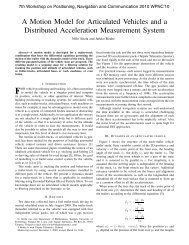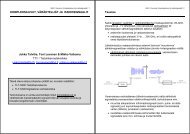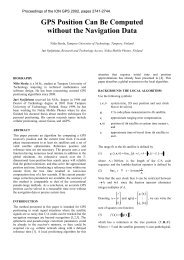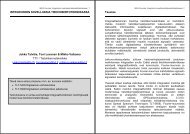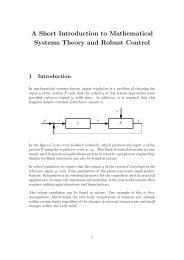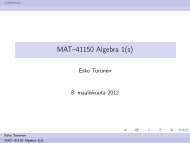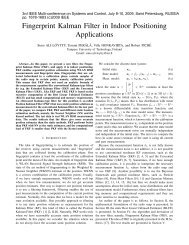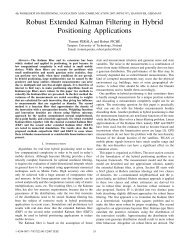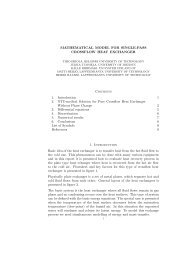Antti Lehtinen Doppler Positioning with GPS - Matematiikan laitos
Antti Lehtinen Doppler Positioning with GPS - Matematiikan laitos
Antti Lehtinen Doppler Positioning with GPS - Matematiikan laitos
You also want an ePaper? Increase the reach of your titles
YUMPU automatically turns print PDFs into web optimized ePapers that Google loves.
proportional to the rate of change of the total electron content of the ionosphere.<br />
The upper limit for the frequency measurement error due to the ionosphere is<br />
0.085 Hz. This value corresponds to the error of 1.6 cm/s in the delta range<br />
measurement[Parkinson & Spilker, p. 495].<br />
The frequency shift due to the ionosphere is a function of transmitted frequency.<br />
Consequently, the users receivingtwo different frequencies can correct for the first<br />
order ionospheric errors.<br />
5.1.2 Receiver Noise<br />
Even if the frequency of the <strong>GPS</strong> signal managed to penetrate the ionosphere<br />
<strong>with</strong>out disturbance, the actual measurement would still cause errors. The properties<br />
of the measurement errors depend heavily on the receiver architecture. The<br />
largest receiver error in the frequency measurement is the clock drift error d. Its<br />
effect on the delta range measurement can be of the order of 10 m/s. Fortunately,<br />
the clock drift error can be taken as an extra variable that is solved for, as was<br />
done in Chapter 4. The order of magnitude of the remaining receiver noise is<br />
hard to estimate theoretically.<br />
5.1.3 Unknown User Velocity<br />
In Subsection 4.3.3 we assumed that the satellite relative velocity vectors vi are<br />
known. With the equation 4.2, vi was defined as wi − wu, wherewi is the<br />
satellite velocity vector and wu is the user velocity vector. The satellite velocity<br />
vector wi can be calculated from the current ephemeris if one knows the current<br />
time. By contrast, the user velocity vector wu is unknown unless one has some<br />
extra information. The most common form of extra information is probably the<br />
knowledge that the user is stationary.<br />
Takingthe vector wu as a variable to be solved for means that we have three<br />
more unknowns, since wu ∈ R 3 . Thus, the number of required satellites for the<br />
positioningincreases from four to the usually unrealistic number of seven. Solving<br />
for wu is not considered any further here.<br />
Let us consider the error that the unknown user velocity causes. Assume that<br />
the user velocity wu is replaced by a biased user velocity estimate wu + △wu.<br />
Then, accordingto the equation 4.2, the satellite relative velocity vectors vi are<br />
32




